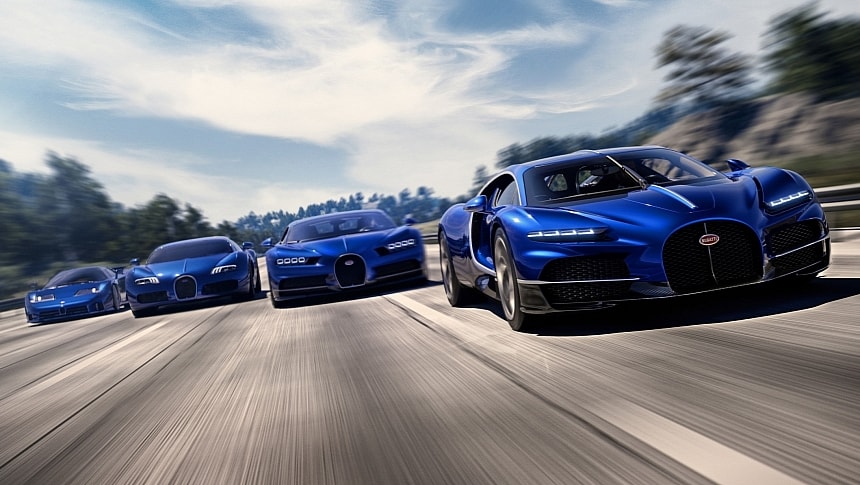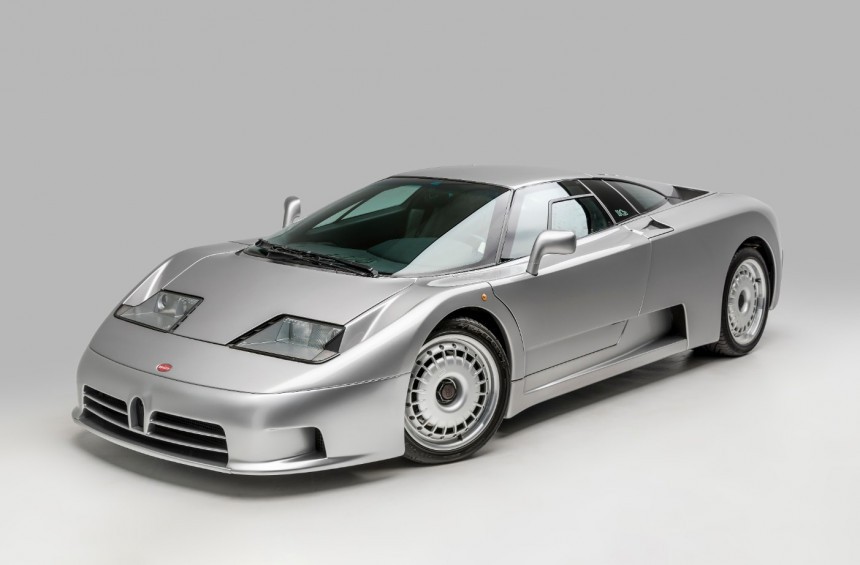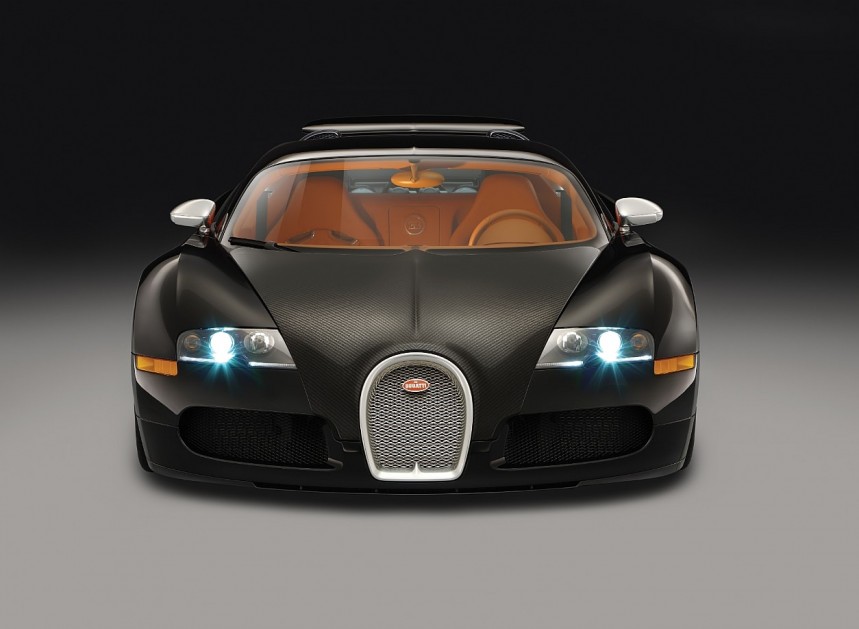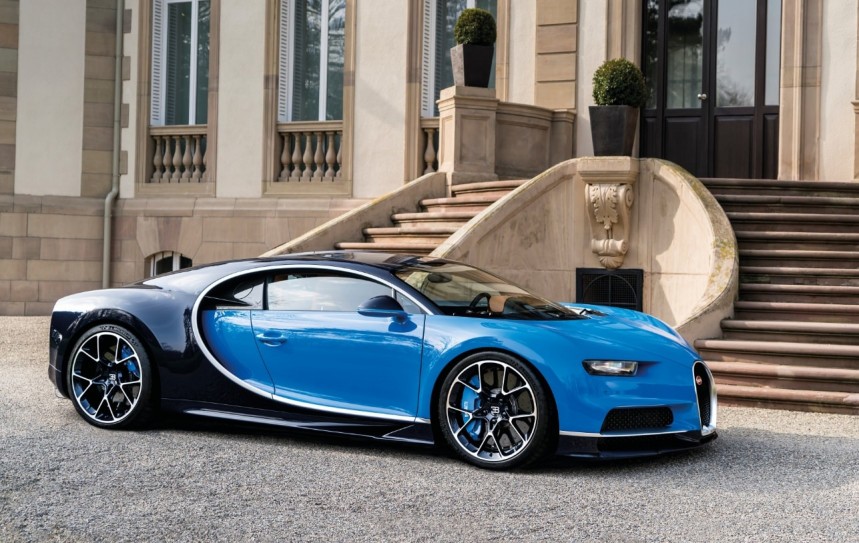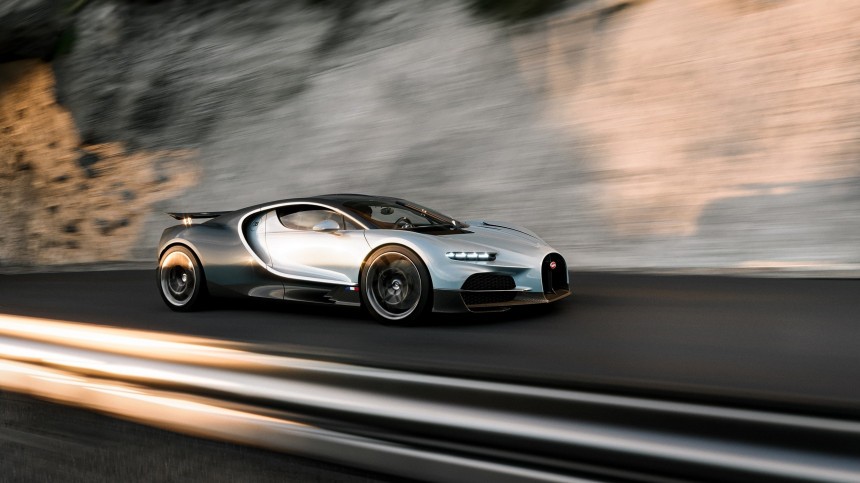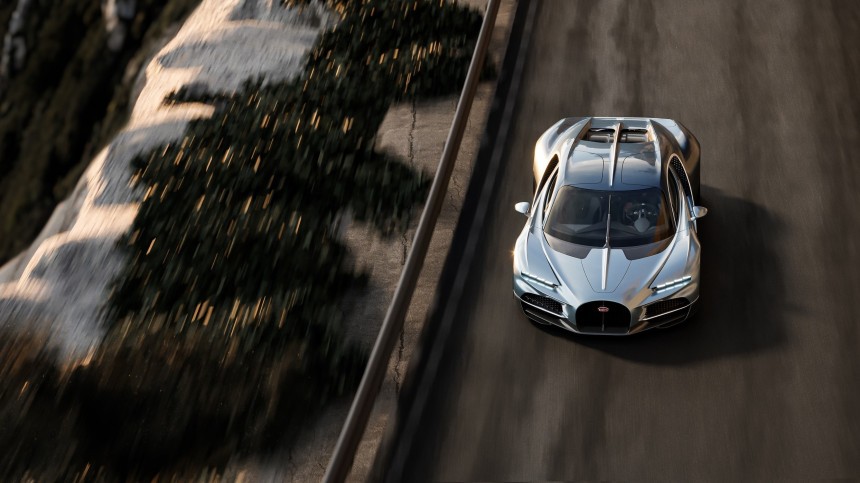Established in 1909, Bugatti became famous for luxury cars like the Type 41 Royale and Type 57 Atlantic and race-winning sports cars like the Type 35. Shut down in 1963 due to financial issues, the company was revived by an Italian entrepreneur in 1987. Four years later, Bugatti launched its first hypercar.
By the time Romano Artioli acquired the brand, no Bugatti automobile had been produced in over three decades. Introduced in 1951, the Type 101 was supposed to restart Bugatti production after World War 2 and Ettore's death in 1947. Developed from pre-war Type 57 chassis, the Type 101 spawned only seven units.
Established in 1987 as Bugatti Automobili S.p.A., the revived carmaker moved from France to Modena, Italy, where Romano Artioli began the construction of a new plant in 1988. The facility was inaugurated two years later, at a time when Artioli had already discussed a brand-new car with Marcello Gandini and Paolo Stanzani.
Bugatti's first modern vehicle debuted in 1991 as a major departure from the company's early designs. A mid-engined automobile aimed at Ferraris and Lamborghinis of the era, the EB 110 featured a rather outlandish design and a quad-turbo, 3.5-liter V12 engine. Rated at 553 horsepower, the EB 110 outgunned the Ferrari F40 in the oomph department.
Only six months after the EB 110 GT went into production, Bugatti unveiled the Super Sport version at the 1992 Geneva Motor Show. Some 330 pounds (150 kg) lighter thanks to carbon-fiber components, the SS version was also notably more potent at 603 horsepower. Bugatti claimed it could hit 60 mph (97 kph) from a standing start in 3.4 seconds toward a top speed of 212 mph (341 kph). A French magazine reportedly drove the EB 110 SS to a top speed of 218 mph (351 kph), which would have been a world record at the time.
In 1993, Bugatti unveiled the EB 112, a four-door luxury sedan. However, the latter did not become a production model. By 1995, Bugatti Automobili S.p.A. went bankrupt, and the unfinished EB 110s were sold to Dauer Racing. The factory was sold to a furniture-making company. Bugatti had built 139 units by then.
The firm was revived once again in 1998 under the Volkswagen Group umbrella. Now called Bugatti Automobiles SAS, the company unveiled the EB 118 concept at the 1998 Paris Auto Show. In 1999, the EB 218 and 18/3 Chiron show cars were followed, all three powered by massive W18 engines.
It took Volkswagen six more years to develop a production model. Unleashed in 2005 as the Veyron 16.4, the new hypercar also marked Bugatti's return to Molsheim, France. Designed by Jozef Kaban, the Veyron was even wilder than the EB 110. Powered by a quad-turbo, 8.0-liter W16 engine, the Veyron hit showrooms with a massive 987 horsepower and 922 pound-feet (1,250 Nm) of torque.
In addition to being the world's most powerful production model, the Veyron also set a new top speed record, hitting 253.81 mph (408.47 kph). But Bugatti didn't stop there. In 2010, the French unleashed the Veyron Super Sport, powered by a 1,183-horsepower version of the W16 engine. The Veyron SS recaptured the Guinness World Record, which the regular Veyron had lost to the SSC Ultimate Aero by hitting a top speed of 267.85 mph (431.07 kph).
Built in 450 units, the Veyron spawned numerous limited-edition models, including the Pur Sang, the first Bugatti with exposed carbon-fiber and aluminum body panels. The company also celebrated its record-setting top-speed run with an SS World Record Edition model limited to five units.
After ten years on the market, the Veyron retired in 2015 to make way for the Chiron. Previewed by the Vision Gran Turismo concept, the Chiron retained the 8.0-liter W16 engine of the Veyron. However, heavy updates increased output to 1,479 horsepower and 1,180 pound-feet (1,600 Nm) of torque, a world record for production cars at the time.
The Chiron's top speed was electronically limited to 261 mph (420 kph) for safety reasons, but that didn't stop the French from setting a new speed record. This was achieved in 2019 with a higher-performance version called the Super Sport 300+. Unveiled for the company's 110th anniversary, the 300+ model shared a 1,578-horsepower W16 engine with the Centodieci.
The beefed-up model became the first production car to hit 300 mph (483 kph). A top speed of 304.77 mph (490.48 kph) was achieved in a pre-production prototype at Ehra-Lessien. The run was verified by the German Technical Inspection Association (TUV), but it wasn't included in the Guinness Book of Records because it was uni-directional. An official record requires a two-way run.
As of 2024, the Chiron Super Sport 300+ remains the only production hypercar that exceeded 300 mph (482.8 kph). The Chiron also broke the record for the fastest 0–400–0 km/h (0–249–0 mph) acceleration time, completing it in 41.96 seconds in 3.2 kilometers (two miles).
Bugatti produced 500 Chirons over eight years. This figure includes various one-ff rigs such as the La Voiture Noire, Pur Sport Grand Prix, and Profilee. The Bugatti Centodieci, a limited-edition tribute to the EB 110, is also based on the Chiron. The hypercar also spawned the track-focused Divo (40 units) and the Mistral roadster (99 examples).
In 2020, rumors began to surface that the Volkswagen Group was preparing to sell the unprofitable Bugatti brand. In July 2021, Bugatti and Rimac Automobili merged to form a joint venture between Rimac Group and Porsche AG. The newly formed Bugatti Rimac company gave both Bugatti and Porsche access to Rimac's battery and powertrain technology.
Not surprisingly, the joint venture spawned the first electrified Bugatti hypercar, the Tourbillon. Announced in June 2024 and set to go into production in 2026, the Tourbillon ditched the long-running quad-turbo W16 engine for a hybrid setup.
The combo brings together a new 8.3-liter V16 gasoline engine co-developed with Cosworth with three electric motors (two at the front axle and one at the rear). The massive V16 generates 986 horsepower, while the electric motors produce a combined 789 horsepower. Bugatti has yet to unveil the Tourbillon's total output, but it's safe to say it will become the company's most potent vehicle.
In addition to adopting electrification and a naturally aspirated engine, Bugatti also changed the transmission's placement. Previously mounted in front of the engine, the gearbox is now positioned longitudinally at the rear of the powerplant. This setup enabled Bugatti to add a 25-kWh battery in the central tunnel. The latter will give the Tourbillon an all-electric range of more than 37 miles (60 km).
Bugatti says the Tourbillon can accelerate from 0 to 60 mph in only two seconds and hit a top speed of 277 mph (445 kph). It's unclear whether the company wants to set a new top speed record, but it's safe to say the Tourbillon trumps the Chiron in just about every other department. The hybrid supercar will be limited to only 250 units, but it will probably spawn other models, too.
EB 110 SS - 603 HP
Veyron - 987 HP
Veyron SS - 1,183 HP
Chiron / Divo - 1,497 HP
Chiron SS / Centodieci - 1,578 HP
Tourbillon - 1,775 HP (unofficial)
EB 110 SS - 218 MPH
Veyron - 254 MPH
Veyron SS - 268 MPH
Chiron - 261 MPH
Chiron SS - 305 MPH
Tourbillon - 277 MPH
EB 110 - The quad-turbo era begins
Bugatti's first modern vehicle debuted in 1991 as a major departure from the company's early designs. A mid-engined automobile aimed at Ferraris and Lamborghinis of the era, the EB 110 featured a rather outlandish design and a quad-turbo, 3.5-liter V12 engine. Rated at 553 horsepower, the EB 110 outgunned the Ferrari F40 in the oomph department.
Only six months after the EB 110 GT went into production, Bugatti unveiled the Super Sport version at the 1992 Geneva Motor Show. Some 330 pounds (150 kg) lighter thanks to carbon-fiber components, the SS version was also notably more potent at 603 horsepower. Bugatti claimed it could hit 60 mph (97 kph) from a standing start in 3.4 seconds toward a top speed of 212 mph (341 kph). A French magazine reportedly drove the EB 110 SS to a top speed of 218 mph (351 kph), which would have been a world record at the time.
In 1993, Bugatti unveiled the EB 112, a four-door luxury sedan. However, the latter did not become a production model. By 1995, Bugatti Automobili S.p.A. went bankrupt, and the unfinished EB 110s were sold to Dauer Racing. The factory was sold to a furniture-making company. Bugatti had built 139 units by then.
Volkswagen Group purchase and the Veyron
It took Volkswagen six more years to develop a production model. Unleashed in 2005 as the Veyron 16.4, the new hypercar also marked Bugatti's return to Molsheim, France. Designed by Jozef Kaban, the Veyron was even wilder than the EB 110. Powered by a quad-turbo, 8.0-liter W16 engine, the Veyron hit showrooms with a massive 987 horsepower and 922 pound-feet (1,250 Nm) of torque.
In addition to being the world's most powerful production model, the Veyron also set a new top speed record, hitting 253.81 mph (408.47 kph). But Bugatti didn't stop there. In 2010, the French unleashed the Veyron Super Sport, powered by a 1,183-horsepower version of the W16 engine. The Veyron SS recaptured the Guinness World Record, which the regular Veyron had lost to the SSC Ultimate Aero by hitting a top speed of 267.85 mph (431.07 kph).
Built in 450 units, the Veyron spawned numerous limited-edition models, including the Pur Sang, the first Bugatti with exposed carbon-fiber and aluminum body panels. The company also celebrated its record-setting top-speed run with an SS World Record Edition model limited to five units.
Chiron and 300+ mph top speed
The Chiron's top speed was electronically limited to 261 mph (420 kph) for safety reasons, but that didn't stop the French from setting a new speed record. This was achieved in 2019 with a higher-performance version called the Super Sport 300+. Unveiled for the company's 110th anniversary, the 300+ model shared a 1,578-horsepower W16 engine with the Centodieci.
The beefed-up model became the first production car to hit 300 mph (483 kph). A top speed of 304.77 mph (490.48 kph) was achieved in a pre-production prototype at Ehra-Lessien. The run was verified by the German Technical Inspection Association (TUV), but it wasn't included in the Guinness Book of Records because it was uni-directional. An official record requires a two-way run.
As of 2024, the Chiron Super Sport 300+ remains the only production hypercar that exceeded 300 mph (482.8 kph). The Chiron also broke the record for the fastest 0–400–0 km/h (0–249–0 mph) acceleration time, completing it in 41.96 seconds in 3.2 kilometers (two miles).
Bugatti produced 500 Chirons over eight years. This figure includes various one-ff rigs such as the La Voiture Noire, Pur Sport Grand Prix, and Profilee. The Bugatti Centodieci, a limited-edition tribute to the EB 110, is also based on the Chiron. The hypercar also spawned the track-focused Divo (40 units) and the Mistral roadster (99 examples).
Rimac merger and Tourbillon
Not surprisingly, the joint venture spawned the first electrified Bugatti hypercar, the Tourbillon. Announced in June 2024 and set to go into production in 2026, the Tourbillon ditched the long-running quad-turbo W16 engine for a hybrid setup.
The combo brings together a new 8.3-liter V16 gasoline engine co-developed with Cosworth with three electric motors (two at the front axle and one at the rear). The massive V16 generates 986 horsepower, while the electric motors produce a combined 789 horsepower. Bugatti has yet to unveil the Tourbillon's total output, but it's safe to say it will become the company's most potent vehicle.
In addition to adopting electrification and a naturally aspirated engine, Bugatti also changed the transmission's placement. Previously mounted in front of the engine, the gearbox is now positioned longitudinally at the rear of the powerplant. This setup enabled Bugatti to add a 25-kWh battery in the central tunnel. The latter will give the Tourbillon an all-electric range of more than 37 miles (60 km).
Bugatti says the Tourbillon can accelerate from 0 to 60 mph in only two seconds and hit a top speed of 277 mph (445 kph). It's unclear whether the company wants to set a new top speed record, but it's safe to say the Tourbillon trumps the Chiron in just about every other department. The hybrid supercar will be limited to only 250 units, but it will probably spawn other models, too.
Output evolution:
EB 110 - 553 HPEB 110 SS - 603 HP
Veyron - 987 HP
Veyron SS - 1,183 HP
Chiron / Divo - 1,497 HP
Chiron SS / Centodieci - 1,578 HP
Tourbillon - 1,775 HP (unofficial)
Top speed evolution:
EB 110 - 212 MPHEB 110 SS - 218 MPH
Veyron - 254 MPH
Veyron SS - 268 MPH
Chiron - 261 MPH
Chiron SS - 305 MPH
Tourbillon - 277 MPH
